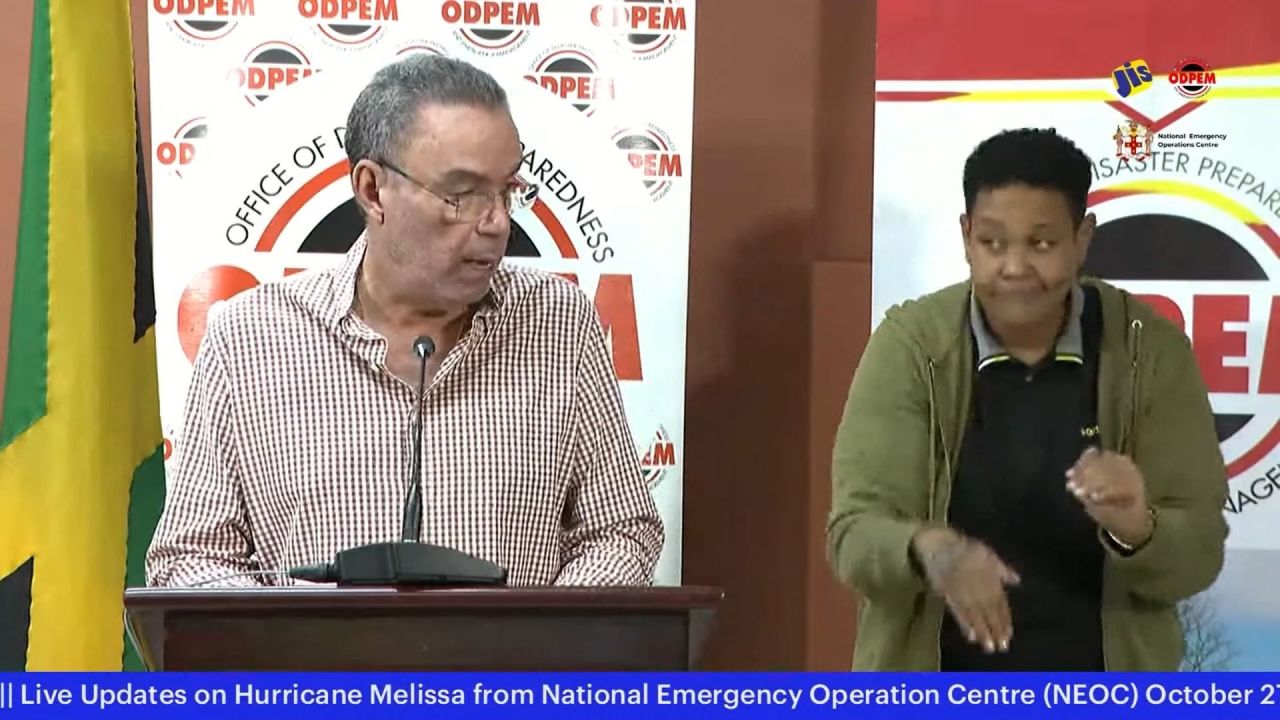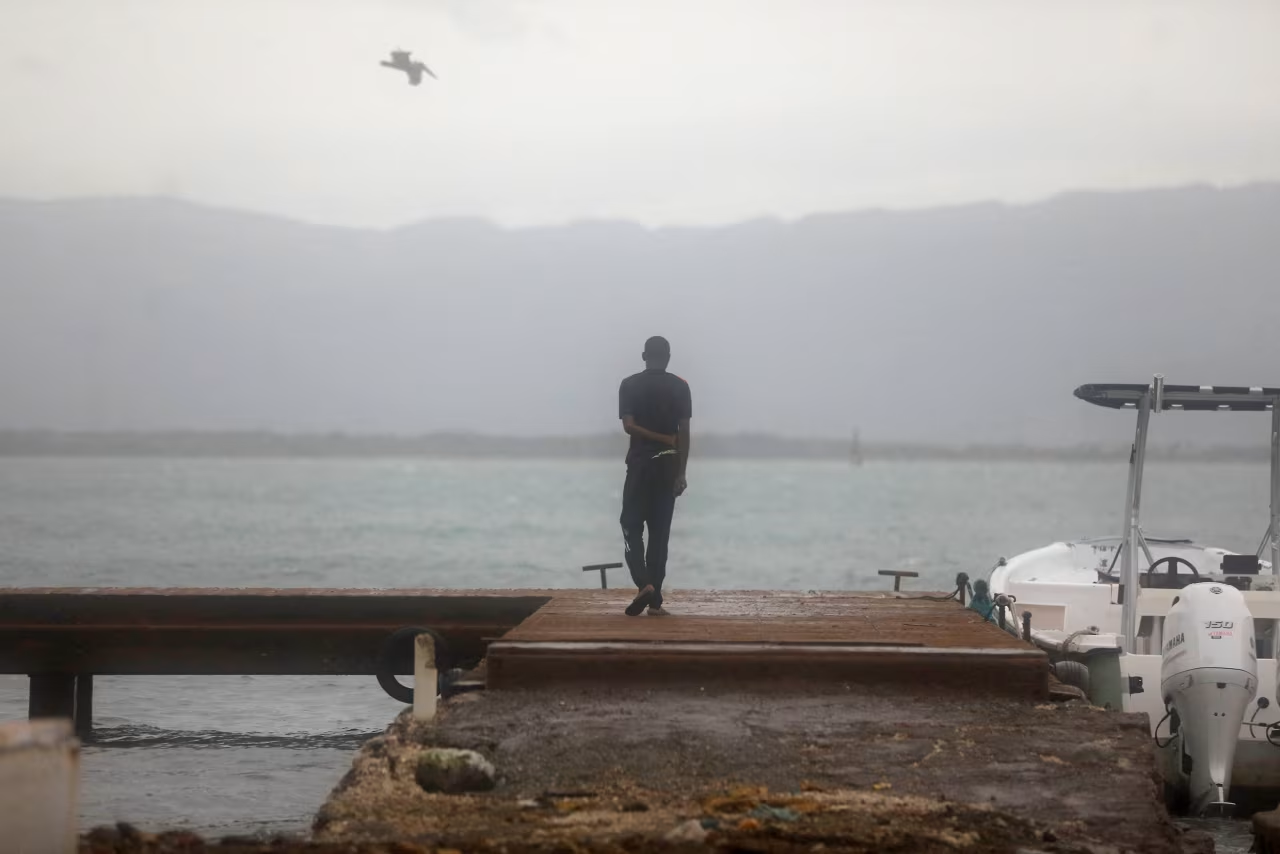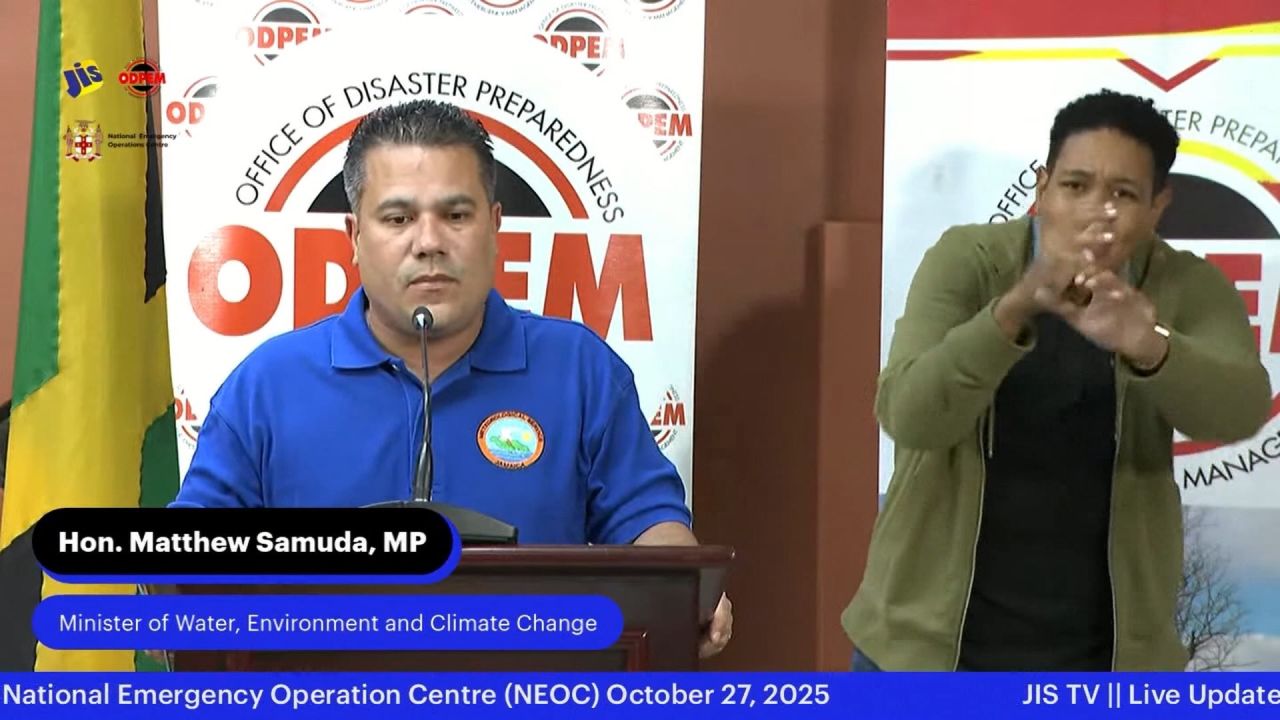What we're covering
• Strongest storm on Earth: Melissa rapidly intensified over the weekend and continues to strengthen. The rare Category 5 has winds of 175 mph, with stronger gusts, making it the strongest storm on the planet this year. Its outer bands are lashing Jamaica with wind and rain.
• Catastrophic impact: Up to 40 inches of rain, 13 feet of storm surge and 160 mph sustained winds will cause “extensive infrastructure damage” that will cut off communities, the National Hurricane Center warned.
• Jamaica’s worst hurricane: Mandatory evacuation orders have been issued for vulnerable coastal areas of Jamaica ahead of what will likely be the strongest storm on record to hit the country. Melissa has already killed three people in Haiti and one person in the Dominican Republic.
• Extreme rapid intensification: Melissa more than doubled in strength over the weekend, increasing its winds by 70 mph in just 24 hours. More tropical systems are rapidly intensifying and wringing out more rain as the atmosphere and ocean warm due to fossil fuel pollution.
NOAA hurricane hunters flying into Hurricane Melissa without pay

The crews on board NOAA’s hurricane hunter aircraft and the ground crews that support them are flying missions into Hurricane Melissa without pay during the government shutdown, according to a NOAA official who spoke to CNN on the condition of anonymity because they were not authorized to speak to the press.
The crews have been encountering extraordinary turbulence in this particular storm. One flight Monday morning was forced to end its mission early in order to make sure the plane had not sustained structural damage.
Meteorologist Andy Hazelton was aboard that particular flight and described the experience to CNN. The plane hit severe turbulence while flying through the southwest portion of the eye wall, where the fiercest winds and heaviest rains are typically located. “You hit a big enough updraft and a big enough downdraft, then you have to make sure the plane is ok,” Hazelton said.
Hazelton has been flying these missions since 2018 and said Hurricane Melissa was “The most turbulent hurricane I’ve ever been in.”
Melissa is now Earth's strongest storm of 2025
Melissa continues to strengthen and is now the strongest storm to roam Earth in 2025.
Its maximum sustained winds are 175 mph with stronger gusts as of 2 p.m ET, according to the National Hurricane Center. That’s a 10 mph increase in winds from the 11 a.m. ET advisory.
The Category 5 hurricane’s center is 145 miles southwest of Kingston, Jamaica, as of 11 a.m. ET. Melissa has started to turn north toward Jamaica and is now tracking west-northwest at 3 mph.
Melissa's most extreme winds will hit higher elevations the hardest
A hurricane’s wind speed is measured from the ground, but the most powerful winds often roar several hundred — or even a thousand — feet above. That’s because friction from trees, buildings and natural terrain slows the air near the surface, while the atmosphere above remains unobstructed.
NOAA aircraft flying through Melissa recorded winds of 220 mph just a few thousand feet above the ground. Meanwhile, ground-level wind speeds were measured at 160 mph.
That difference matters in higher-elevation communities like Mandeville, about 2,060 feet above sea level and home to roughly 50,000 people. Winds there could be up to 60 mph stronger than along the coast — a gap that could bring exponentially greater damage risk.
“Catastrophic winds in the eyewall have the potential to cause total structural failure especially in higher elevation areas tonight and early Tuesday,” according to a NOAA advisory.
State Department “closely" monitoring Jamaica's aid needs for Hurricane Melissa
The US State Department is continuing to “closely monitor” Hurricane Melissa and “evaluate the need to send assistance,” according to a department spokesperson.
The department would be the agency responsible for administering foreign disaster aid to Jamaica. It has prepositioned emergency relief supplies in six warehouses to distribute supplies to Jamaicans impacted by the hurricane, the spokesperson said.
The Bureau for Humanitarian Assistance, which oversees foreign disaster aid, was merged into the State Department after the Trump administration closed the US Agency for International Development (USAID) earlier this year. It’s unclear how the closure of USAID could impact the flow of aid to Jamaica or other countries hit by Melissa.
“We have the ability to provide life-saving assistance to affected countries and people across the globe when it is in the interest of the United States,” the spokesperson said. “The decision to deploy additional capability will not be made until a need is identified.”
The State Department has warehouses around the world to distribute aid to various regions impacted by disasters such as hurricanes, earthquakes and tsunamis.
Melissa's turbulence was so rough that a "hurricane hunter" flight had to abort

Hurricane Melissa pushed a research plane to its limit, forcing hurricane hunters to abort a mission Monday morning.
“NOAA aircraft left the storm early after experiencing severe turbulence in the southwestern eyewall,” the National Hurricane Center wrote in Melissa’s latest forecast discussion.
Hurricane hunters are no stranger to powerful winds and intense turbulence, so what happened Monday morning is remarkable. These teams routinely fly specialized aircraft into the most powerful storms on the planet to collect weather data, which is used to improve track and intensity forecasts.
But this flight was “definitely the most turbulent I’ve ever experienced,” Andy Hazelton, a hurricane expert who confirmed he was on the plane, said on X.
According to a NOAA official, who spoke on the condition of anonymity because they were not authorized to speak to the press, there were no injuries aboard the aircraft but the plane and the crew were “beat up bad.” It is rare but not unheard of for a hurricane hunter flight to change course or leave a storm due to severe turbulence.
Aircraft positioning data shows that the plane — a WP-3D Orion — was able to take at least two passes through Melissa’s center, collecting critical weather data before experiencing the dangerous turbulence that sent researchers heading for safety.
CNN’s Thomas Bordeaux contributed to this report.
Jamaican ministers warn of “massive flooding” while urging public to use emergency shelters

Massive flooding is unavoidable no matter where Hurricane Melissa makes landfall, Jamaica’s transport minister said on Monday.
Meanwhile, Minister for Local Government Desmond McKenzie shared his concerns about low uptake in the use of emergency shelters across the country that are available for those in vulnerable areas.
“There are over 800 shelters across Jamaica. Of the 800 shelters that are open, only 76 of the 800 shelters are seeing any activities at all,” McKenzie said at a press conference. “There are four parishes that have no one in the shelters.”
McKenzie said the government is anticipating that “close to 50,000 persons will be relocated, either moving to safe grounds or in the shelters.”
Jamaican coastal communities will be “most impacted” by hurricane, says meteorologist

Residents in low-lying neighborhoods along Jamaica’s coastline will be most exposed to heavy rainfall, storm surges, and strong winds, a senior meteorologist warned Monday, hours before Hurricane Melissa was set to make landfall.
“The areas around that coastline are going to be most impacted,” Evan Thompson, the principal director of the Meteorological Service of Jamaica, told journalists.
Melissa will likely emit the strongest hurricane winds in western parishes of the Caribbean nation. Tropical storm force winds will cover nearly the entire island, Thompson said.
He also warned that landslides are “a very real possibility and likelihood, because as the soil is saturated and the soil is loose.”
In Kingston, streets are quiet as residents brace for the powerful storm

In Jamaica’s capital city, the streets are relatively quiet ahead of Melissa’s landfall. The Category 5 is expected to be the strongest storm in the country’s history.
Some vehicles are loaded with plywood as residents make final preparations. The government issued mandatory evacuation orders Sunday evening for several vulnerable coastal communities, including parts of Kingston.
There’s been light rain with some gusts of wind.
At the hotel where a CNN field crew is staying, exterior doors have been boarded up with sand bags piled in front to help combat the water expected to pour on the city overnight.
Kingston’s geography is like a bowl and many residents told CNN they fear the island’s beautiful mountains will also funnel great amounts of rain into the city.
Jamaican minister warns public not to cross flooded gullies
Jamaican Minister Robert Morgan warned the public not to cross flooded gullies on Monday as Hurricane Melissa looms, threatening to bring torrential rain and flash flooding to the island.
Over the weekend, workers in Jamaica’s capital Kingston dredged as much trash and silt as they could from the bottom of Sandy Gully, an approximately 20 km long waterway snaking along the city’s western flank.
When Melissa brings its months’ worth of rain as it passes over Jamaica, the swollen, debris-filled gully could knock out bridges, splitting Kingston in two.
“We’ve had historical evidence of persons in very powerful vehicles seeking to traverse gullies. And they lost the competition,” Morgan said at a press conference while urging the public to report damage to Jamaica’s authorities.
"The time for preparation is all but over," Jamaica's climate change minister says

Jamaica’s climate change minister said Monday that the time for preparation is “all but over” as Hurricane Melissa moves toward the island.
Samuda encouraged people on the island to use resources sparingly and warned that disruption to the water system could start as soon as tonight.
“You will start to see disruption to water systems, we imagine, later this evening going into early morning tomorrow,” he said. “Now is definitely the time to put aside your water for storage and to use sparingly. Every drop will count.”
“The time for preparation is almost at an end,” Samuda again stressed.
Beryl showed hurricanes don't have to make landfall to deliver a blow in Jamaica

It’s been 13 years since a hurricane made landfall in Jamaica. However, last year showed it doesn’t take a landfall to cause big problems in the island nation.
While Sandy in October 2012 was the last hurricane to come ashore in Jamaica, Hurricane Beryl tracked just south of the island as a Category 4 in July 2024. Floods and high winds caused damage to homes, crops and other infrastructure, especially in southern areas.
The storm killed four people and caused an estimated $1 billion in damage, according to the hurricane center report.
Hurricane Gilbert in 1988 was the last Category 4 or stronger hurricane to make landfall in Jamaica. Melissa is poised to be the most powerful hurricane on record to come ashore.
NOW: Jamaican government officials are giving an update on Hurricane Melissa
Jamaican government officials are now giving updates about the progress of Hurricane Melissa as it churns toward Jamaica.
The press conference is taking place at the country’s Office of Disaster Preparedness and Emergency Management.
The speakers include:
• Dana Morris Dixon, minister of Education, Skills, Youth & Information
• Desmond McKenzie, minister of Local Government
• Matthew Samuda, minister of Water, Environment and Climate Change
• Robert Morgan, minister without portfolio for the Ministry of Economic, Growth and Job Creation
• Evan Thompson, Jamaica’s principal director of the Meteorological Service
We will bring you more updates as we get them.
Jamaica improved infrastructure after Hurricane Gilbert, but its never been tested by winds like Melissa's

Melissa may well be the most powerful hurricane to hit Jamaica since 1988, when at least 40 people were killed in the wake of Hurricane Gilbert.
Authorities have replenished the electricity grid since then and reinforced housing, according to Matthew Samuda, Jamaica’s minister of water, environment and climate change.
“We’re certainly better prepared than we would have been in the ’80s,” he told CNN on Monday. “But when you speak about 160 mph winds, we’ve never tested our new infrastructure in that regard.” Gilbert had 135 mph winds when it made landfall on the island.
Hurricane Melissa, which currently has 165 mph winds, is the 45th Category 5 hurricane on record in the Atlantic and the third Category 5 storm this season. Storm surges — a rise in water level caused by a strong storm’s wind pushing water onshore — could peak between nine to 13 feet.
Watch: Waves and wind lash Jamaica as Hurricane Melissa approaches

Powerful winds whip up along Jamaica’s coastline Monday as Hurricane Melissa closes in.
Jamaican government minister urges residents to heed evacuation orders

A senior government minister in Jamaica has called on people to follow mass evacuation orders, ahead of what could be the most ferocious storm to hit the country in decades.
Matthew Samuda, the minister of water, environment and climate change, implored residents to travel to shelters and reach high ground on Monday, as the government braced for Hurricane Melissa — the 45th Category 5 hurricane on record in the Atlantic.
Communities on the coasts will be particularly exposed to destructive winds, catastrophic flooding and life-threatening storms — and seventy percent of the Jamaican population live within five kilometers of coasts, Samuda said.
The government has erected 800 shelters across the country, according to Samuda. Meanwhile, crews from the national bus service, the country’s defense forces and disaster preparedness unit are mobilizing mass evacuations.
“Go to the shelters. Go to higher ground because this can take lives,” he said.
Melissa puts on a lightning show
Melissa’s almost perfectly circular, clear eye is an obvious sign of the hurricane’s tremendous power.
The eye of a hurricane is an area of relatively calm weather surrounded by the storm’s fiercest winds – the eyewall. Melissa’s eyewall was sparking with lightning this morning, indicating a lot of energetic thunderstorm activity.
Constant thunderstorm activity often a sign of a strengthening hurricane.
Melissa strengthens again
Hurricane Melissa is still strengthening as it crawls toward Jamaica late Monday morning.
Melissa now has sustained winds of 165 mph, according to the National Hurricane Center. That’s a 5 mph increase from earlier this morning.
The Category 5 hurricane’s center is 145 miles southwest of Kingston, Jamaica, as of 11 a.m. ET. It’s drifting to the west at just 3 mph.
Melissa is slow, even by human standards
Melissa has been tracking at what’s considered a human’s slow walking pace of just 2 to 3 mph since late last week. It’s moved just 150 miles since Thursday afternoon, or about the distance between New York City and Baltimore.
The average forward speed of a hurricane where Melissa is located is about 10 to 11 mph, according to the National Oceanic and Atmospheric Administration’s Hurricane Research Division.
Melissa’s slow movement over warm water that extends deep into the ocean along with improving wind conditions high in the atmosphere allowed it to explode in strength over the weekend and Monday.
Warming ocean water from climate change has caused the rapid intensification of hurricanes to become more likely.
Here's what Melissa looks like from space

The sun rose to reveal a terrifying image of Category 5 Hurricane Melissa Monday morning. The center of the monstrous hurricane was just over 100 miles from the southern coast of Jamaica, but its clouds and storms had completely obscured the island from view.
Melissa’s center is easy to spot, just look for the eye – the clear space amid all the cloudiness.
Has a Category 5 hurricane ever hit Jamaica?
In short, no, not in recorded history.
Since reliable records began in 1851, no Category 5 hurricane has ever made landfall in Jamaica. The strongest known storm to affect the island was Hurricane Gilbert in 1988, which approached from the east as a Category 4.
Gilbert remains Jamaica’s benchmark hurricane. It destroyed more than 100,000 homes, wiped out power and communications, and killed 45 people.




